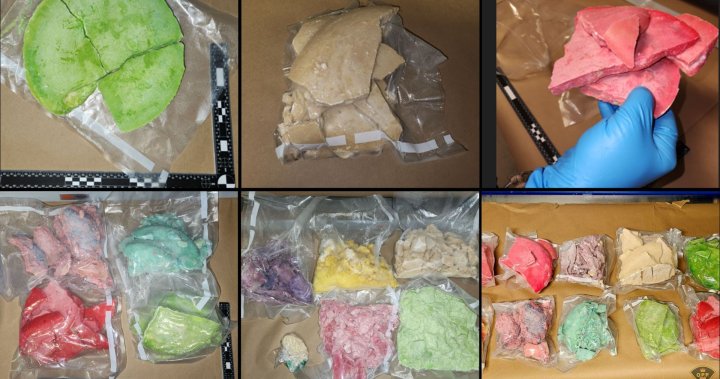Uncategorized
Ontario police seize enough fentanyl to kill ‘a moderately sized city’ in record bust

OPP say officers seized more 43 kg of fentanyl, along with large quantities of other drugs like meth and cocaine, as a result of two recent large-scale investigations.
In total, police said they had taken more than $7 million worth of drugs off the streets.
Although the two investigations you will hear about today are independent of one another, they both resulted in an alarming seizure of fentanyl and showcase an intricate level of drug trafficking.
“These investigations took place on opposite ends of our province, which demonstrates the broader public safety issue,” OPP Commissioner Thomas Carrique told reporters at a press conference announcing the drugs busts on Wednesday in Orillia.
“Between the two investigations there was a staggering 43.5 kg of fentanyl seized which equates to approximately 435,000 potentially lethal street level doses.”
Given all the rhetoric flowing from south of the border, Carrique made certain to note that the fentanyl was for distribution in Canada.
“At this time, there is no indication that the fentanyl seized through these investigations was destined for exportation to the United States or any other country,” he offered.
One of the investigations, which police dubbed Project Golden, began in July 2024 and was focused on a drug trafficking network which was based in southwestern Ontario.

Get daily National news
Get the day’s top news, political, economic, and current affairs headlines, delivered to your inbox once a day.
Police said the investigation initially began in the Norfolk County area but eventually OPP and police in Hamilton realized they were both onto the same case and began to work together.
“In January of this year, intelligence sharing between the Hamilton Police Service and the Ontario Provincial Police identified connections to common targets, prompting the launch of a joint investigation,” Hamilton police superintendent Marty Schulenberg told reporters.
OPP say the investigation led officers to conduct raids at 16 homes and businesses in Oxford County, Norfolk County, Hamilton, Mississauga, York Region, Burlington and Toronto on May 28.
During the raids, officers seized 38 kg of fentanyl, 19.5 kg of methamphetamine and 5.5 kg of cocaine, as well as psilocybin and MDMA, which police estimate to be worth $5.4 million.
“The fentanyl seized was enough for approximately 380,000 street-level doses – an amount capable of taking the lives of a moderately sized city,” a release from police noted.
“Analysis shows the fentanyl seized through this investigation had been mixed and cut with other substances and was not pure fentanyl, meaning it varied in potency, which has been taken into consideration when estimating street-level doses.”
The officers also captured three guns, brass knuckles, $121,600 and three vehicles which police say was offence-related property.
“The firearms recovered in this investigation underscore the reality that where there are illicit drugs, there is often the threat of violence,” Schulenberg said.
Police say 15 people from across southern Ontario including Hamilton, Norfolk County and Mississauga were arrested in connection with Project Golden and they are facing a combined 140 charges.
“Information obtained by the investigative team revealed the involvement of high-level suppliers of fentanyl and other drugs,” OPP Acting Det.-Supt. Andy Bradford with the Organized Crime Enforcement Bureau said.
The other investigation, which police say was titled Project Bionic, lasted five months and looked into operations using the dark web marketplace to ship drugs across Canada.
“The investigation revealed that orders would be placed through the dark web marketplace, then packaged and shipped to locations across Canada using various courier services and Canada Post,” Bradford explained.
“On March 10th 2025, members from the organized crime enforcement bureau arrested two individuals at a postal service location in Ottawa where 86 packages were seized containing various illicit drugs ready to be shipped across the country.”
Later that day, officers also raided three homes and a vehicle in Gloucester and Nepean where they seized a gun, $95,000 and a stolen 2018 Ferrari 488 Spider convertible valued at more than $400,000.
Police seized large quantities of fentanyl, methamphetamine, MDMA powder, heroin, cocaine, ketamine, hash, hydromorphone tablets, methylphenidate tablets, morphine tablets, as well as a number of other types of drugs which they value at $2.5 million.
Police say officers also seized a number of items that would be used in car thefts, including fraudulent licence plates, reprogrammable key fobs and a diagnostic and programmer tool.
“A subsequent search warrant on March 27th resulted in the recovery of 11 additional stolen vehicles from a location on the outskirts of Ottawa,” Bradford said.
“It is important to recognize the linkage between drug trafficking and other criminal activities, including auto theft. Those engaged in criminal activity rarely confine themselves to a single crime.”
The list of stolen vehicles included two Toyota Highlanders, three Toyota Sequoias, five Toyota Tundras and a Lexus RX which were valued at $730,000.
Police say four people from Ottawa were arrested and are facing 85 charges in connection with Project Bionic.
© 2025 Global News, a division of Corus Entertainment Inc.
Uncategorized
Blue Jays reinstate Gimenez from injured list

TORONTO – The Toronto Blue Jays reinstated second baseman Andres Gimenez from the 10-day injured list Tuesday and designated infielder Buddy Kennedy for assignment.
Gimenez, a three-time Gold Glove award winner, missed five weeks with a left ankle sprain.
Related Videos
The moves were announced shortly before the Blue Jays opened a three-game series against the visiting Chicago Cubs.
Entering play Tuesday night, Gimenez had five homers, 23 RBIs and a .218 average.

Get daily National news
Get the day’s top news, political, economic, and current affairs headlines, delivered to your inbox once a day.
Kennedy had one hit in two games for the Blue Jays. He also played four games for the Philadelphia Phillies earlier this season.
This report by The Canadian Press was first published Aug. 12, 2025.
© 2025 The Canadian Press
Uncategorized
Man dead, another in custody after stabbing in Toronto’s east end


Around 2:30 p.m., Toronto police said they were called to the area of Woodbine and Duvernet avenues for reports someone had been stabbed inside a neighbouring home.
Source link
Uncategorized
Jays’ Shapiro says he wants to remain with team

TORONTO – Blue Jays president Mark Shapiro declined to comment on contract extension talks Tuesday but said he wants to remain with the club and that team ownership has been “reciprocal in that desire.”
Shapiro, who also serves as chief executive officer, is in the final year of his contract.
“When I think about alternatives, I’ve never been a grass is greener guy,” he said in a pre-game availability. “Twenty-four years in one place in Cleveland and 10 years here now.
Related Videos
“So it’s the appreciation for what I have and the people that I get to work with every day, the city that I work in and the country that I live in, those things are drivers for me to remain here.”
Shapiro, 58, joined the club in 2015 and signed a five-year extension in January 2021.

Get daily National news
Get the day’s top news, political, economic, and current affairs headlines, delivered to your inbox once a day.
He took questions from reporters for about 20 minutes in a rare in-season media session. Shapiro was asked directly whether there had been discussions with team owner Rogers Communications on a new deal.
“Sure, yeah, I mean I think (it’s) not appropriate for me to comment beyond the fact that what I just said is I want to remain here,” Shapiro said. “And I can also say that both (Rogers executive chair) Edward (Rogers) and (Rogers president/CEO) Tony (Staffieri) have been reciprocal in that desire.”
It has been a worst-to-first campaign for Canada’s lone Major League Baseball team. The Blue Jays finished last in the American League East division standings last season but have enjoyed a stellar season in 2025.
Toronto entered Tuesday night’s game against the visiting Chicago Cubs with the best record in the AL at 69-50.
This report by The Canadian Press was first published Aug. 12, 2025.
© 2025 The Canadian Press
-

 Uncategorized2 months ago
Uncategorized2 months agoAccording to Dior Couture, this taboo fashion accessory is back
-

 Uncategorized2 months ago
Uncategorized2 months agoThese ’90s fashion trends are making a comeback in 2017
-

 Uncategorized2 months ago
Uncategorized2 months agoThe old and New Edition cast comes together to perform
-

 Uncategorized2 months ago
Uncategorized2 months agoUber and Lyft are finally available in all of New York State
-

 Uncategorized2 months ago
Uncategorized2 months agoNew Season 8 Walking Dead trailer flashes forward in time
-

 Uncategorized2 months ago
Uncategorized2 months agoMeet Superman’s grandfather in new trailer for Krypton
-

 Uncategorized2 months ago
Uncategorized2 months ago6 Stunning new co-working spaces around the globe
-

 Uncategorized2 months ago
Uncategorized2 months agoThe final 6 ‘Game of Thrones’ episodes might feel like a full season







